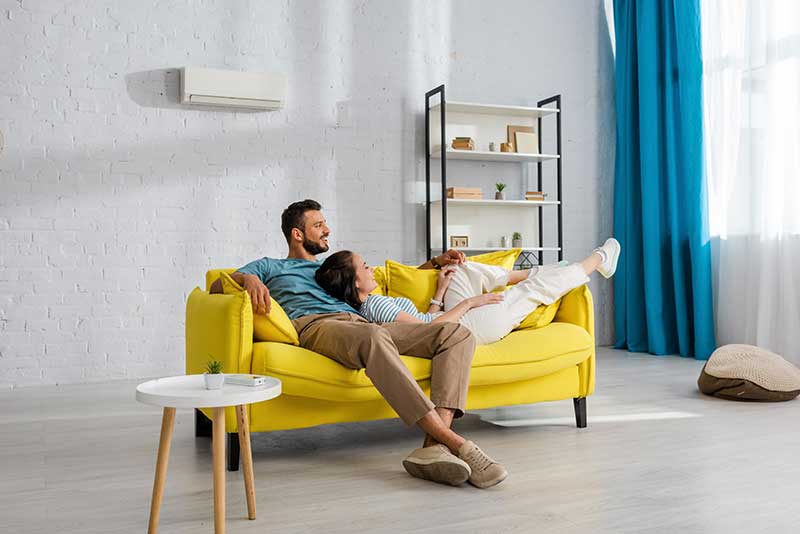A traditional wall-mounted AC is one of the least expensive ways to add air conditioning to your home, but it’s not the only option. Ductless wall-mounted ACs, also called heat pumps or mini splits, require a larger upfront investment, but they offer more efficiency, quieter operation, and other benefits.
To help you assess the differences between these two options, we’ve put together this post comparing wall-mounted ACs vs. wall-mounted ductless units. Have questions right now? Then, contact us at NETR, Inc today.

What Is a Wall-Mounted AC?
A wall-mounted AC is a standalone air conditioning unit that mounts to an exterior wall of your home. It can also refer to a wall-mounted ductless AC that connects to an outside condenser.
People use the phrase wall-mounted AC to refer to both ductless and traditional wall-mounted ACs, and both types of units mount to your wall and cool your home. However, to reduce confusion, we use the following definitions in this guide:
- Wall-mounted AC — A standalone air conditioning unit that mounts to an exterior wall of your home. Traditionally, it features a sleeve that goes into a hole in your wall, and then, the AC unit goes into the sleeve.
- Window AC — A standalone air conditioning unit that goes into a window of your home. In some cases, people cut holes in their walls and install window ACs as if they are wall-mounted ACs.
- Wall-mounted ductless AC — This is an AC supported by a heat pump that mounts to any wall and connects to an external condenser. It is also called a mini-split, a heat pump AC, or a wall-mounted ductless unit.
If you opt for a ductless AC, you don’t have to get a wall-mounted design. You can also choose from a floor mount or a ceiling mount.
Cost of Wall-Mounted AC Vs. Ductless Heat Pump
This is the one category where wall-mounted ACs are the clear winner. You can buy a basic wall-mounted air conditioner for just a few hundred dollars, but even if you go for all of the bells and whistles, the price tops out at around $1,000. Installation varies but ranges from $60 to $200.
In comparison, a single-zone ductless AC with an outdoor condenser and an indoor air handling unit starts at about $4,500 including installation, and the price goes up from there. A two-zone heat pump costs between $8,500 and $12,000, while systems with between five and eight zones can be anywhere from $20,000 and up.
Installation for Wall-Mounted AC Vs. Heat Pump AC
To install a wall-mounted AC, you need to cut a hole into your wall. To hold the AC, these holes generally end up being at least 18 x 24 inches. In contrast, when you install a wall-mounted ductless AC, the installer only needs to cut a two to three-inch hole so that refrigerant, condensation, and electrical lines can run from the interior to the exterior unit.
However, with a ductless AC, you will need to find a spot for an outdoor condenser. Typically, these go on the ground on the side or back of your home, but as needed they can be placed on roofs. With a wall-mounted AC, you don’t need an exterior condenser. The AC contains all of the equipment that it needs to run.
Cost of Operating Wall-Mounted AC Vs. Ductless AC
A ductless heat pump is much less expensive to run than a wall-mounted AC. According to EnergyStar.gov, the most efficient wall-mounted ACs use about 700 kWh/year to support a cooling capacity of 10,000 BTUs. This is about what you need to cool a 350 to 450-square-foot room.
Ductless heat pumps can cool the same area using 30 to 40% less electricity. The exact savings vary based on the size of your home, the efficiency of the units you select, and the cost of electricity, but this comparison of window ACs and ductless heat pumps suggests a monthly savings of $55 per month in a relatively small home.
Noise Levels of Wall-Mounted and Ductless Air Conditioners
Wall-mounted ductless heat pumps are significantly quieter than wall-mounted ACs. Ductless heat pumps generate about 32 decibels of sound. Most wall-mounted ACs operate at a noise level of 78 to 82 decibels, with high-quality models at the 72-decibel mark.
To put these sound levels into comparison, a big truck generates about 80 decibels of noise when it barrels past, while general city traffic is about 70 decibels. A whispered conversation is about 30 decibels. To put it another way, most window ACs are on par with noisy traffic out an open window, and ductless heat pumps are about the same noise level as a whispered conversation.
In general, home appliances tend to make between 40 and 60 decibels of sound, making a ductless unit quieter than most appliances and the window AC louder.
On-Off Cycling on Wall-Mounted ACs
Both wall-mounted ACs and ductless heat pumps have built-in thermostats. You set the temperature and the system kicks on the cooling when the room reaches that temperature.
However, standard wall-mounted ACs power on when the temperature drops, and then, they power off after they’ve cooled the room to the target temperature. This constant on-off cycling takes up a lot of power, and it can also lead to inconsistent temperatures in your home.
Ductless mini splits also use the thermostat settings as a guide on when to increase or decrease their cooling efforts. But rather than turning on and off repeatedly, ductless heat pumps use their fans to keep the room at a continuous temperature. This saves energy.
Fan Settings for Wall-Mounted ACs
As indicated above, ductless heat pumps get a lot of their efficiency because of the smart way they control their fans. Their fans run constantly between 30 and 100% capacity. They automatically make adjustments to keep the room at a consistent temperature and minimize energy consumption.
If desired, you can get units with multiple vanes that direct the cool air in different directions through your home. There are also wall-mounted ductless ACs with features such as occupant sensors which adjust the direction of the air based on where people are in the room.
Standard wall-mounted ACs also use fans to move the air around the room, but their fans aren’t automatic. You have to adjust them manually. Typically, they come with just three speeds. This reduces comfort levels, compared to a ductless AC.
Air Filtration of Wall-Mounted ACs
The majority of your home’s air runs through your air conditioner. If you have a lot of dust, pet dander, allergens, etc, in your air, that will go into your AC and blow back into your room. This is why built-in filtration is critical.
Most window-mounted ACs come with a filter that you can remove and clean, and as long as you keep the filter clean, it will provide some protection to your indoor air quality. Ductless heat pumps also have filters that need to be cleaned or replaced regularly. But most ductless ACs offer HEPA filters or other types of advanced filtration options that exceed what you get with a standard wall-mounted AC.
How Wall-Mounted ACs Deal With Condensation
All ACs cool your home by extracting warm air and humidity from your space. This can dry out your home, potentially leading to respiratory irritation. However, these systems deal with condensation differently.
Wall-mounted ACs don’t have a great design for removing condensation from the unit. As a result, water can build up in the wall around your unit. People who have had wall-mounted ACs for 15 to 20 years often discover a lot of mold and rot when they remove the unit. This can require extensive contracting repairs and mold remediation.
In contrast, when a ductless heat pump produces condensation, it drains to the outside condenser through a condensation pipe. It doesn’t drip along the outside of your home or into your walls.
Placement Options for Wall-Mounted ACs
Wall-mounted ACs must be placed on exterior walls. They need to discharge air outside. The placement of wall-mounted ductless units is more flexible. You can put them on any wall as long as it has studs to support the weight of the unit. This means that you get to choose the spot that creates the most comfort.
Unfortunately, most wall-mounted air conditioners don’t work that well because most of them are actually window air conditioners. When you install a window AC into a hole in the wall, the system can’t extract the discharge air properly. This happens because window ACs are designed to discharge the air through a window that’s one to two inches thick, and their functioning gets compromised when they’re placed in a six-inch thick wall.
Heating With a Ductless Heat Pump
With a ductless AC, you can easily add heating to the unit, and it doesn’t drive up the cost that much. Ductless heat pumps offer more efficiency than most traditional home heating options, and they also enhance the comfort of your home.
In contrast, the majority of wall-mounted ACs don’t come with heat. There are some models, especially the ones used in hotels, that offer an electric heating option. However, they can’t heat as efficiently or at as low temperatures as ductless heat pumps.
Contact NETR, Inc to Talk About Wall-Mounted ACs
Should you buy a wall-mounted AC or a wall-mounted ductless unit? Ultimately, the choice is yours. If you want the cheapest upfront investment, a wall-mounted AC is the best option, but if you want to invest in your home’s comfort and value, a ductless wall-mounted heat pump is the best option. Want to learn more about ductless heating and cooling? Then, contact us today. At NETR, Inc, we have been meeting the heating and cooling needs of home and business owners for over 30 years, and we’d love to send a comfort consultant to your home to help you select the best option for your situation.

